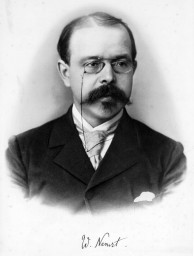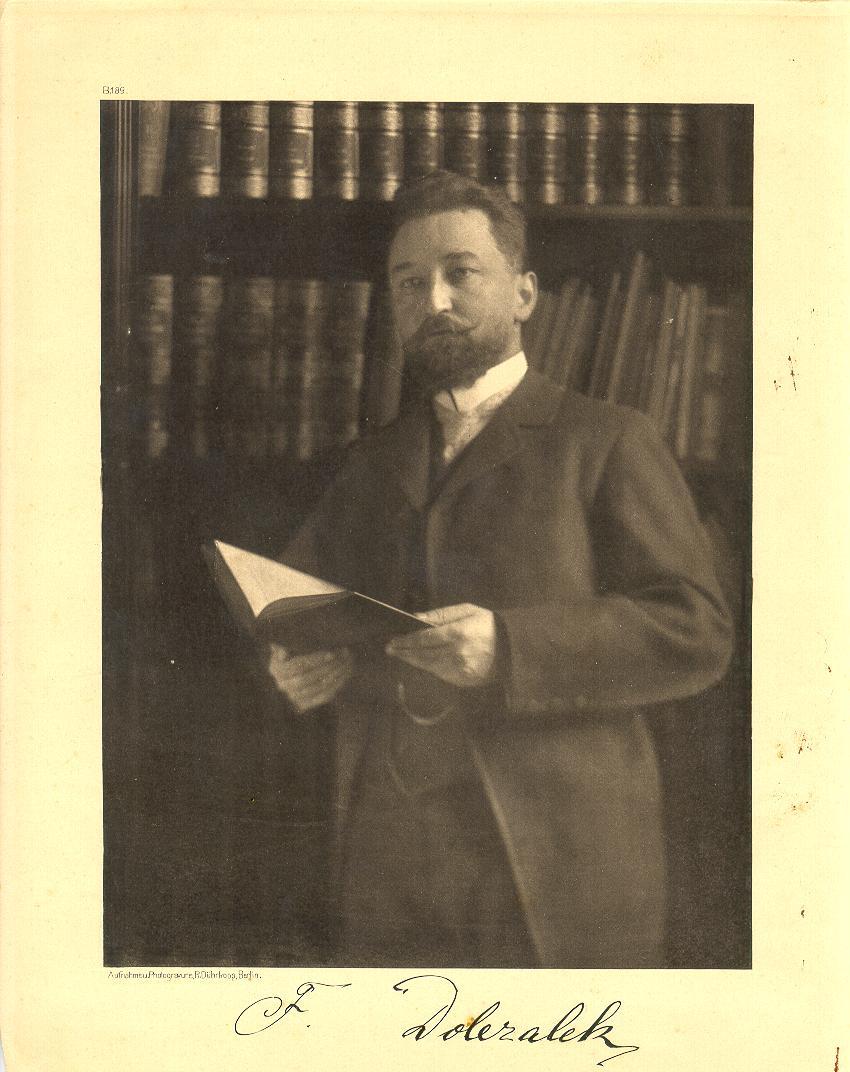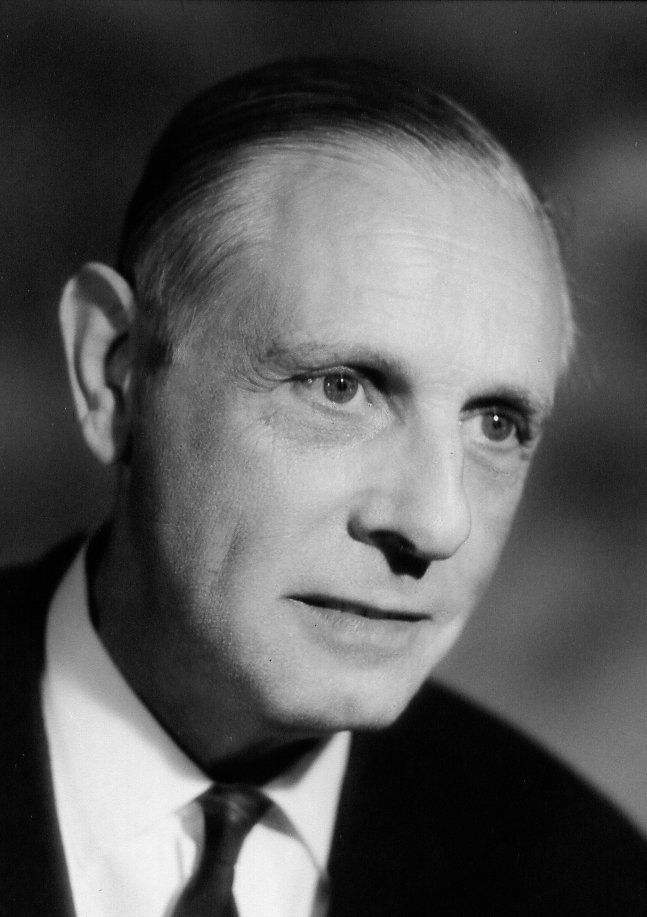 1895 - 1905
1895 - 1905Walther Nernst (b. 1864-06-25 in Briesen, West Prussia) came to Göttingen from Leipzig (habilitation with Wilhelm Ostwald) in 1890 as private lecturer and assistant of Eduard Riecke at the physics institute. He was appointed extraordinary professor in 1891 and ordinary professor in 1894. He wrote a seminal textbook on physical chemistry ("Theoretische Chemie vom Standpunkte der Avogadroschen Regel und der Thermodynamik") whose first edition was printed 1893. In 1895 the physicochemical institute was founded, making use of an already existing building (Bürgerstr. 50), and Nernst was appointed its director. The inauguration ceremony took place 1896-06-02. Nernst invented a novel electric incandescent lamp based on solid-state electrolytes, and he was able to sell his patent (1897) in 1898 to the AEG (director Emil Rathenau) for a huge sum of which he donated 40000 Mark to enlarge the institute building. Research was performed predominantly in electrochemistry as well as on electric properties (dielectric constants) and on gas phase equilibria at very high temperatures. In 1905 Nernst was appointed director of the Berlin physicochemical institute. 1905-12-23 he reported the discovery of his Heat Theorem (Neuer Wärmesatz, Third Law of thermodynamics) at a meeting of the Königliche Gesellschaft der Wissenschaften (Royal Academy of Science) in Göttingen. Nernst initiated the seminal Solvay Congress in Brussels in 1911. Nernst was awarded the Nobel Prize in Chemistry 1920 "in recognition of his work in thermochemistry". In 1922 Nernst was appointed director of the Physikalisch-Technische Reichsanstalt (successor of Emil Warburg) until 1924 when he was appointed professor of physics at the university until his retirement in 1933. Nernst died 1941-11-18 at his country estate Rittergut Zibelle (Oberlausitz, near Muskau) at age 77. Later his mortal remains were transferred to the Göttingen municipal cemetery where they rest close to other celebrities of the science community.
 1905 - 1907
1905 - 1907
Friedrich Dolezalek (b. 1873-02-05 in Mar[a]maros-Sziget, Austria-Hungary, Transylvania, now Sighetu Marmatiei, Romania) was a student of Nernst in Göttingen. He worked in the field of electrochemistry, and he developed a very sensitive (5 microvolt) quadrant electrometer in 1896. Subsequently he worked predominantly on the practically important lead accumulator. He then worked with F. Kohlrausch at the Physikalisch-Technische Reichsanstalt in Berlin (1900) and for Siemens & Halske on long distance telephone cables and other electrical engineering challenges (1901). In 1904 he was appointed professor at the Technische Hochschule Danzig and subsequently extraordinary professor and director of the Göttingen physicochemical institute when Nernst left for Berlin in 1905. In 1908 he changed to the Technische Hochschule Charlottenburg (Berlin) where his research focussed on liquid phase equilibria. Dolezalek died 1920-12-10 in Berlin at age 47.
F. Dolezalek and W. Nernst. Eine neue Form des
Quadranten-Elektrometers. Z. Elektrochem. 3 (1896) 1 - 3.
Alfred Schulze. Friedrich Dolezalek. Z. Elektrochem. 27 (1921)
89 - 92 (obituary, with bibliography).
Gustav Tammann (b. 1861-05-28 in Jamburg, near St. Petersburg, Russia) came to Göttingen from Dorpat (now Tartu, Estonia) in 1903 when he was appointed director of the newly founded inorganic chemistry institute. In 1908 he was appointed director of the physicochemical institute. His interests focussed on the physics and physical chemistry of metals (metallurgy). He wrote textbooks on "Kristallisieren und Schmelzen", "Metallkunde" and "Heterogene Gleichgewichte". Other keywords related to his work are: glasses, amorphous phases, diffusion and solid state reactions, high temperature and high pressure physics, thermal analysis. In 1926 Tammann was awarded the Liebig-Denkmünze (Verein Deutscher Chemiker, now GDCh). 1936-05-28 (75th birthday) he was awarded the Adlerschild des Deutschen Reiches with the dedication "Dem Altmeister der deutschen Metallurgie". Tammann died 1938-12-17 in Göttingen at age 77.
Dr. HO. v. Samson-Himmelstjerna. Die Forschungen Gustav Tammanns in ihrer Bedeutung für die deutsche Metallkunde. Die Umschau in Wissenschaft und Technik, Jahrgang 43, Heft 4, 1939-01-22, pp. 88 - 90.
Arnold Eucken (b. 1884-07-03 in Jena) was a student and coworker of Nernst in Berlin. He worked on specific heats and quantum effects at low temperatures. PhD 1906, habilitation 1911. In 1915 Eucken was appointed director of the physicochemical institute at the Technische Hochschule Breslau. In 1929 Eucken was appointed director of the Göttingen physicochemical institute. He wrote seminal textbooks on physical chemistry ("Grundriss der physikalischen Chemie", "Lehrbuch der chemischen Physik"). Some keywords of his research areas are: structure of liquids and electrolytic solutions, molecular vibrations, internal rotation, homogeneous and heterogeneous gas kinetics, supercritical solutions, chemical engineering and technology. Among his coworkers were Klaus Clusius, Ernst Bartholomé, Edward Teller, Klaus Schäfer, Hans Sachsse, Franz Patat, Gerhard Damköhler and Ewald Wicke. One of his last PhD students was Manfred Eigen (b. 1927-05-09), winner of the Nobel Prize in Chemistry 1967. Eucken died 1950-06-16 in Seebruck (Kr. Traunstein, Chiemsee) at age 65.
1950 - 1953
Ewald Wicke (b. 1914-08-17 in Wuppertal-Elberfeld) studied in Köln and in Göttingen (with A. Eucken) where he got his PhD. In 1944 he obtained his habilitation. He was appointed extraordinary professor in 1949 and subsequently (after Eucken's death) interim director of the Göttingen physicochemical institute. Wicke continued research projects of Eucken and worked on thermodynamics of solutions, interfaces, catalysis, transport processes, coal combustion and other subjects in chemical engineering and technology. 1954 he was awarded the Fritz-Haber-Prize of the Bunsengesellschaft and subsequently was appointed director of the Hamburg physicochemical institute. 1959 he changed to Münster where he retired 1982. Wicke died 2000-03-07 in Münster at age 85.
 1953 - 1971
1953 - 1971
Wilhelm Jost (b. 1903-06-15 in Friedberg, Hessen) studied in Halle and München (1921 - 1926). PhD thesis on diffusion in ionic crystals. Subsequently he went to Berlin as coworker of Max Bodenstein where he habilitated in 1929. Until 1937 he worked at the Technische Hochschule Hannover, interrupted by a Rockefeller Research Fellowship at MIT (1932/33). He was appointed professor in Leipzig (1937), in Marburg (1943), at the Technische Hochschule Darmstadt (1951) and finally in Göttingen (1953). His research interests focussed on diffusion processes in solids, thermodynamics and technique of distillation, as well as on the kinetics of gas phase reactions, in particular in relation to combustion processes and flames. He wrote textbooks on "Explosions- und Verbrennungsvorgänge in Gasen" and on "Diffusion in Solids, Liquids, Gases", and he continued Hermann Ulich's textbook "Kurzes Lehrbuch der physikalischen Chemie" (6th ed. 1954; subsequently continued by J. Troe, 18th ed. 1972). Jost died 1988-09-23 in Göttingen at age 85.
Revised 2006-01-07